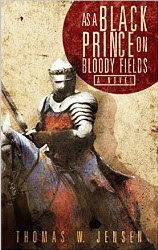This is
Episode 12 of a series of posts investigating the dramatic and contradictory record
of the life of Sir Thomas Malory, author of “Le Morte d’Arthur,” the seminal
book of King Arthur and his knights.
Episode 1 can be found here.
March,
1451. Sir Thomas Malory, literary
knight, an accomplished veteran of the French wars and landowner, three times Member of Parliament, (for
Warwickshire, Greater Bedwyn and, most recently Wareham in November of 1450) is
married with a son. He is around 50 and
may even have begun work on his magnum opus of distilling over 34 sources in
three languages into the single epic which informs so much of our imagination and perception, of
knighthood, chivalry and gentility.
On March 15th of that year, the King’s Council suddenly issued a warrant for his arrest, along with his servant, John Appleby and 18 others, most associated with his household. They are accused of “diverse felonies, transgressions, insurrections, extortions and oppressions.” As far as I can make out from “Documenting Sir Thomas Malory,” Baugh, A. C., in Speculum, A Journal of Medieval Studies, January 1933 which contains the most comprehensive quotations of the accusations against Malory, no greater detail was provided.
At this time
the void in power within the King’s Council left by the exiled and assassinated
Duke of Suffolk, had been filled by the Dukes of Somerset and Buckingham. The warrant was turned over to Sir William
Mountfort, High Sheriff of Warwickshire, MP for Warwickshire 7 times and its
wealthiest knight, who, like Malory, was a veteran of the French wars and had
served as Captain of Honfleur in 1438.
Interestingly, according to Carole Rawcliffe’s biography The Earls of Stafford and Dukes of
Buckingham, Montfort had at one time been close to Buckingham. However, eleven years before, when Sir
William wished to change his will and release manors to his eldest son and
heir, Buckingham required Montfort to make Buckingham himself a feofee (a kind
of trustee) for the property as well and “through his greatness so terrified
(Mountfort) with threats” that he was forced to disclaim his younger children
from any inheritance.
In 1451,
Montfort, who was also a Malory family friend, possibly in spite of some
danger, took no action on the warrant.
Four months
later, on July 13, 1451, a second warrant was issued, not to the Sheriff, but
to the Duke of Buckingham himself. This
warrant required that Malory and Appleby “shall cause no injury or evil to the
prior and convent of the Carthusian Order of the Isle of Axholme” and they’re
ordered to appear before the King’s Council on October 13-14 to answer charges
to be preferred against them. Further, the
arrest of Malory and Appleby is ordered wherever they’re found, not just within
Warwickshire. The priory itself was
located in North Lincolnshire but one of its holdings was Monks Kirby in
Warwickshire to which the warrant may have been referring.
On a Sunday
morning twelve days later, Buckingham and 60 followers rode the 13 miles from
his manor at Atherstone to Newbold-Revel where he executed the warrant
personally. Sir Thomas was arrested and
taken the 11 miles to Coventry where he was remanded into the custody of Mountfort. This is interesting, given Mountfort’s
previous behavior. Why didn’t Buckingham
incarcerate Malory in his own castle, Maxstoke, which was 18 miles away? Did he fear having Malory on the road for
that length of time, possibly after dark?
The sequel suggests there could have been good reason to fear a rapid
popular response to free Malory. Was
Buckingham asserting his authority over Mountfort? Whatever the reason, Mountfort then chose to
incarcerate Malory in his own moated manor at Coleshill, possibly because it
was more comfortable than other alternatives.
Two nights
later, Malory escaped. It’s recorded
that he swam the moat, which may have been no small feat given that medieval
moats could be particularly foul. He
returned to Newbold-Revel where on the next day, (according to another
indictment discussed below) he raised a diverse band of 100, including his cook
and groom, and armed them. They then
rode to neighboring Coombe Abbey which they formally assaulted using “great
baulks of wood” to batter open gates and doors.
They allegedly insulted the
abbot, broke open two of the abbey‘s chests, stole £40 of silver, gold and
jewels, and broke open three other corded and sealed iron chests which,
provocatively, were not described as the property of the abbey.
Why? Had Malory after 50 years of aspirational military and public service suddenly turned to a capricious life of crime? Or, perhaps, when Malory was arrested were documents taken from Newbold-Revel which established property rights or his innocence on charges that would later be preferred against him? What was he looking for? What, if anything, can we deduce of his ability to raise such a force so quickly from those on his estate? The labor shortages resulting from the Black Plague in the previous century and the decline in serfdom which began with the Peasants’ Revolt of 1381 indicate many, if not all of his followers, had other alternatives than to participate in an action that just possibly could have been interpreted as treasonous and certainly was criminal. The punishment for treason was horrific.
Where Malory went or what he did immediately afterwards is unknown. Did he return to Newbold-Revel and prepare for a siege? Did he and a band of followers take refuge in one of the great forests? The next mention of Malory is in the records of a special court convened by the Duke of Buckingham at the exclusive Nun’s Priory of Nuneaton in Warwickshire on the 23rd of August. The Duke himself sat in judgment, accompanied by two Warwickshire lawyers and Sir William Birmingham of Birmingham. There is no mention of Malory’s participation; it is assumed he was not present and may not even have been summoned. The purpose of the court was to indict. Indictments were read in Latin and a jury of fifteen local men then swore to their truthfulness. None of Hardyment, Field or Baugh record anything of the literacy of the jury, whether or not, for example, some level of comprehension of Latin was required.
Seven accusations
were made against Malory:
First, and
most seriously, he was accused of attempting to assassinate Buckingham himself in
Coombe Wood more than eighteen months before (the details are discussed here.) This is the first, and, to my knowledge, only
record of the event. The conflict of
interest in Buckingham’s participation as a justice goes without saying.
Next, Malory
was accused of the attack on Coombe Abbey mentioned above. Two accusations of extortion from individuals
follow, one for £5 on May 31st and another for £1 on August 31 of the
previous year.
What is
perhaps most discordant are two accusations of rape which come after. It was alleged that Malory had raped Joan
Smyth, wife of Hugh Smyth in Monks Kirby on the 23rd of May and
again on the 8th of August of the previous year. On the latter occasion, he purportedly also
broke into the Smyth’s house and stole £40 of goods. The indictment makes it clear that this was
not just abduction but sex as well, “et cum ea carnaliter concubit.” Did this indicate forcible sexual
assault? It may have.
Curiously,
at that point a new jury was impaneled for the final charge: that Malory and four others “extortionately
took seven cows, two calves, a cart worth £4, and 335 sheep worth £22” from two
Leicestershire men and carried them away to Newbold-Revel on June 7, 1451,
which was before his first arrest.
A careful look at the 15th Century laws for rape in England, which had been recently changed, is merited along with examination of each of the charges and their consequences. Is it possible to ascertain Malory’s guilt or innocence? Before attempting to do so it’s necessary to examine Buckingham’s relationships with other notable Warwickshire families, not just the Mountfort’s, but the Ferrers and Harcourts, too. Indeed, as I’ve stated before, a careful look at the life of the Duke himself is necessary and I expect to be able to do so shortly. Some apparent ancillary details, such as Montfort’s experience with Buckingham in 1438, lead to some important and surprising deductions.
Episode 13 can be found here.
A careful look at the 15th Century laws for rape in England, which had been recently changed, is merited along with examination of each of the charges and their consequences. Is it possible to ascertain Malory’s guilt or innocence? Before attempting to do so it’s necessary to examine Buckingham’s relationships with other notable Warwickshire families, not just the Mountfort’s, but the Ferrers and Harcourts, too. Indeed, as I’ve stated before, a careful look at the life of the Duke himself is necessary and I expect to be able to do so shortly. Some apparent ancillary details, such as Montfort’s experience with Buckingham in 1438, lead to some important and surprising deductions.
Episode 13 can be found here.
(The first
image is a portion of “The Hearthly Paradise”; the second is “The Prince Enters
the Forest. Both are by Sir Edward Burne
Jones. The final photograph is of St.
Mary’s Abbey Church, Nuneaton.)











